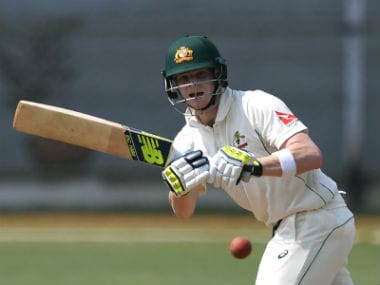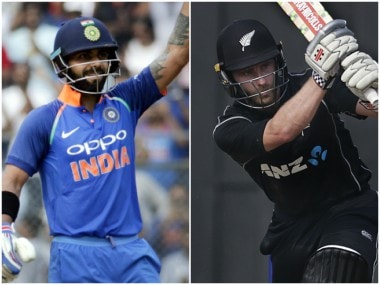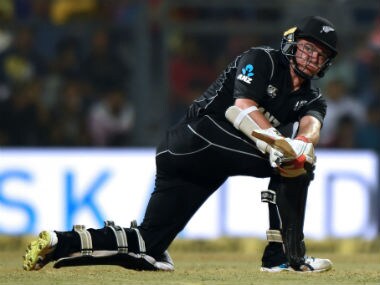What will be the impact of two new balls in women's cricket? Top cricketers discuss
Until now, women’s ODIs were played with just one ball, so this represents unexplored territory for the women’s game. Firstpost spoke to a number of top female cricketers around the world about how this would change the game.
Snehal Pradhan, Oct, 25 2017
- Pakistan and Sri Lanka in UAE, 5 ODI Series, 2017 PAK Vs SL Pakistan beat Sri Lanka by 9 wickets
- Bangladesh in South Africa, 3 ODI Series, 2017 SA Vs BAN South Africa beat Bangladesh by 200 runs
- New Zealand in India, 3 ODI Series, 2017 IND Vs NZ New Zealand beat India by 6 wickets
- West Indies in Zimbabwe, 2 Test Series, 2017 ZIM Vs WI West Indies beat Zimbabwe by 117 runs
- Pakistan and Sri Lanka in UAE, 5 ODI Series, 2017 PAK Vs SL Pakistan beat Sri Lanka by 7 wickets
- Bangladesh in South Africa, 2 T20 International Series, 2017 SA vs BAN - Oct 26th, 2017, 09:30 PM IST
- Pakistan and Sri Lanka in UAE, 3 T20 International Series, 2017 PAK vs SL - Oct 26th, 2017, 09:30 PM IST
- Pakistan and Sri Lanka in UAE, 3 T20 International Series, 2017 PAK vs SL - Oct 27th, 2017, 09:30 PM IST
- West Indies in Zimbabwe, 2 Test Series, 2017 ZIM vs WI - Oct 29th, 2017, 01:00 PM IST
- New Zealand in India, 3 ODI Series, 2017 IND vs NZ - Oct 29th, 2017, 01:30 PM IST
| Rank | Team | Points | Rating |
|---|---|---|---|
| 1 | India | 4493 | 125 |
| 2 | South Africa | 3767 | 111 |
| 3 | England | 4497 | 105 |
| 4 | New Zealand | 3114 | 97 |
| 5 | Australia | 3294 | 97 |
| Rank | Team | Points | Rating |
|---|---|---|---|
| 1 | South Africa | 6386 | 120 |
| 2 | India | 6054 | 119 |
| 3 | Australia | 5948 | 114 |
| 4 | England | 6156 | 114 |
| 5 | New Zealand | 5293 | 113 |
| Rank | Team | Points | Rating |
|---|---|---|---|
| 1 | New Zealand | 1625 | 125 |
| 2 | Pakistan | 2417 | 121 |
| 3 | West Indies | 2395 | 120 |
| 4 | England | 2029 | 119 |
| 5 | India | 2488 | 118 |





Change is in the air in cricket. There are plans for a new Test and ODI Championship system. Some (mostly) welcome tweaks to the rules of the game were just implemented. And there are changes in women’s cricket too.
With the start of the new cycle of the ICC Women’s Championship, the qualification pathway for the top eight teams to the ICC Women’s World Cup in 2021, a new set of playing conditions has also been applied to women’s ODIs. The biggest change is the introduction of two new balls, one at each end, a practice that was adopted in men’s cricket back in 2011. Until now, women’s ODIs were played with just one ball, so this represents unexplored territory for the women’s game. Firstpost spoke to a number of top female cricketers around the world about how this would change the game.
File picture of Anya Shrubsole. Reuters
How do you feel about the changes that have been made, specifically having two new balls?
Jhulan Goswami, India fast bowler:
As a medium pacer you have more chance to do something with the new ball. The white ball gets worn out very quickly, it loses shine after about four to five overs, and all the balls come straight. So now it will be a bit of a challenge for the batswomen. So definitely there is some excitement for the bowlers.
Dane van Niekerk, South Africa captain:
I'm very excited. We've spoken about it for a while now and just glad it got implemented in the Women's game. I think it's great because the ball will stay harder for longer and we can use the new ball for longer as well. We pride ourselves on our pace bowlers and this will be great for us.
Marizanne Kapp, South Africa fast bowling all-rounder:
I do believe it will be better. I am a bit annoyed with the amount of batting wickets that are produced these days. What happened to the days where you would have an even contest between bat and ball? I think it is really tough to be a bowler these days, so I would always welcome two new balls. It will make the contest a bit easier upfront, but obviously bowlers are going to have to work even harder on bowling at the back end, because the ball will be harder.
Anya Shrubsole, England fast bowler:
If you can get the ball to swing, it’s an advantage for the bowling team, especially in certain places around the world, but it does have a knock on effect of the balls being harder at the end of the innings, so scoring might be greater at the end of the innings. So what I think it will do is put a lot of pressure on bowing teams around the world , they are going to have to get better at the death, you’re not going to get away with a big margin for error.
Was there a need for this rule change? Did you see the ball going soft or discoloured after about 35 overs?
Jess Jonassen, Australia left-arm spinning all rounder:
Yeah it has. I think especially over here in Australia, there are a few grounds that are quite coarse, and the ball kind of gets roughed up. The ball is softer, harder to hit for the batswomen, and for the bowlers who can’t get anything out of it. It’s also a matter of being hard to see.
Van Niekerk:
Yes definitely. The balls started to look bad in the 35th over and very soft. It was hard to get the ball away as well as gripping the ball when bowling from the 35th over and on. Especially in the subcontinent where the wickets have a lot more rough than grass.
Reverse swing will probably be the biggest loser. But does women’s cricket see less reverse swing to begin with?
Shrubsole:
I think there are a few factors to it. We don’t bowl as quick as the guys, so I don’t think reverse swing comes into the game that much. Also I think there’s been a lack of awareness and education around it in the women’s game, so I think it’s heavily reliant on pitches. We play on pitches and outfields that aren’t really conducive to reverse swing.
Jonassen:
I haven’t seen much of it. Ellyse Perry has got it to reverse swing a few times, but even in the men’s game you don’t see much reverse in the shorter formats.
Kapp:
I absolutely love the reverse swing factor, it is something that really helped me at the back end especially when playing in the sub continent.
But with two new balls, do you think that is one aspect that will be lost to the women’s game?
Shrubsole:
I think it’s something that potentially now won’t come into the game with two new balls. You’d have to have a pretty abrasive surface and outfield for the ball to scuff up enough to reverse.
Kapp:
I guess the only negative side to this is the reverse swing factor, it will be a lot harder to get the ball to reverse. I don’t think it will be lost completely, I still think that in the sub’ you will be able to get reverse swing.
With women hardly playing any long-form cricket, is there a danger of the next generation of female cricketers growing up without knowing reverse swing at all?
Shrubsole:
Potentially. You probably see even in the men’s game at the death you see less and less (reverse) with two new balls, because it’s almost impossible to get it going in only 25 overs. So I think it’s something that might go out of the game a bit in limited overs cricket, but I guess what you lose at the end you potentially gain at the beginning with the ball swinging longer.
Jonassen:
I enjoy watching any cricket, and in the (men’s) test arena you’ll still have the opportunity to see reverse swing. I know that women don’t play many Test matches, but if you’re watching cricket, you can see that happen in (men’s) Tests. Also, it’s a greater benefit to have the ball swinging early on in an innings, because not every team has bowlers that are capable of producing reverse swing, but they have bowlers who can produce conventional swing.
How do you think this will affect the spin bowlers? Have you ever benefitted from bowling with an older ball?
Laura Marsh, England off-spinner:
I think at some point it’s nice when the old ball is a bit older and it’s harder for batswomen. But (with two new balls) I think it’s also a benefit the ball being a bit harder, especially in Australian conditions, I might be able to extract more bounce from the pitch, and the seam will stay harder as well for longer, which could assist me in getting some turn.
Jonassen:
I don’t think I’m too concerned. We have seen it’s not really the ball that dictates how much spin you get, it’s also the pitch, I think even though the ball is not turning you can be aggressive with whatever ball you use.
Van Niekerk, South Africa leg-spinner:
In some sense, yes, because the ball is also a lot softer so it’s harder to hit the ball. But sometimes the ball becomes so soft that as a leg-spinner I couldn’t grip the ball anymore because the seam isn’t as prominent as it should be.
I believe it's the wicket and not so much the ball. Yes, a brand new ball won't spin as much as the older ball, but we usually bowled after the first 10 overs and at that stage the ball wasn't as worn and on some pitches we still got purchase on the wicket.
Will this be better for the spectators?
Marsh:
Yes, with a harder ball, there will potentially be more boundaries hit all the way through the innings. More sixes as well. It should make for a pretty exciting spectacle.
Laura Wolvaardt, South Africa opening batswoman:
Yes I think this will be good. Sometimes when the ball gets soft and old the game slows down a bit. With the harder new ball, batswomen will be able to hit it further, making the game more exciting for viewers. More swing will also be present throughout the game, possibly leading to wickets and tougher conditions–also more exciting for viewers.
The author is a former India cricketer, and now a freelance journalist. She shares her experience through her YouTube Channel, ‘Cricket With Snehal’, and tweets @SnehalPradhan
Published Date:Oct 25, 2017
| Updated Date: Oct 25, 2017
Also See
Rahul Dravid speaks in favour of ICC's new batting rules, calls it a good decision
WTA Finals: Karolina Pliskova brushes past sluggish Venus Williams in one-sided opener
Tashkent Challenger: Yuki Bhambri reaches doubles quarters with Divij Sharan, advances to Round 2 in singles